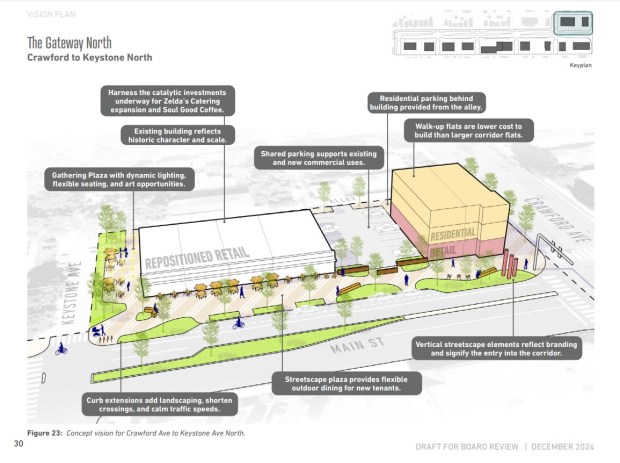After gauging responses from residents near the area of Main Street and Crawford Avenue in Skokie about what they would like to see in the area, which some have described as blighted, the village of Skokie published and presented a draft of a 20-year plan to revitalize the area with local businesses, public spaces, housing and green spaces.
Skokie’s Community Development Director Johanna Nyden presented to the Village Board at its Dec. 2 meeting a study and renderings of a reimagined Main Street corridor in Skokie that are designed to foster community in the immediate area. Nyden emphasized that the plan was closer to a vision for the area, and not a concrete plan for redevelopment, but she said that the village does want to take steps that will lead to further development in the area.
Much of the interest from the village to invest in the area surged after a local community group held popular block club parties, called Meetup on Main, near the intersection of Main Street and Keystone Avenue. The group’s organizer, Lissa Levy, said the parties were inspired by the corridor’s rich history as an economic hub and third space for the community that today is lined with vacant stores.
In June, the village approved awarding Soul Good Coffee and Zelda’s Catering up to $175,000 in Storefront Enhancement Program grants and property tax breaks to rehab a vacant building at 4012-4024 Main Street to house those businesses. The Village Board also approved spending $180,000 for the village to acquire a vacant storefront at 4051 Main Street.
In August 2023, the village hired the consultant group MKSK for $65,000 to assist the village in conducting a study for Main Street between Crawford Avenue and Kildare Avenue. The first step was to analyze the area’s existing physical condition and economic influences, and the consultants took input from local businesses, organizations and residents and identified opportunities for change.
In June, the village and representatives from MKSK presented their preliminary draft at a Meetup on Main event to gather more feedback from the community. Per village documents, the village received a $600,000 grant from the Illinois Department of Commerce and Economic Opportunity to support early work to implement the study.
Skokie’s vision for Main Street
Nyden said the corridor was split into five areas titled The Gateway, Meetup on Main, The Anchor, The Hive and Community Connector. Most of the envisioned blocks are on the south side of Main Street, with the exception being the first block west of Crawford Avenue on Main Street. The envisioned redevelopment would stretch from Crawford Avenue to Tripp Avenue.
The first block, between Keystone Avenue and Crawford Avenue characterized as The Gateway, will house the incoming Zelda’s Catering, Soul Good Coffee and third retail space. The village also recommends adding a shared parking lot accessible through the alley and a mixed-use building on that end. Nyden said many of the existing buildings in the area have a 30-foot setback between the buildings and the street curb, which the report identifies as an opportunity to create small plazas and add green space. The village’s report also encourages higher density and taller mixed-use buildings on the south side of Main Street on that first block and a shared surface parking lot.
The Meetup on Main block, between Keystone Avenue and Karlov Avenue, is intended to remain as a gathering place with open spaces for people to gather. Functionally, the block would host two larger buildings, one as a signature building and one as existing retail space.
The Anchor block between Karlov Avenue and Kedvale Avenue would largely stay the same, with Zelda’s Catering being expected to remain and for future developments to lean into a similar business practice, either through outdoor dining, partnerships with Zelda’s and ghost kitchens.

The Hive block between Kedvale and Keeler Avenues is envisioned to host two mixed-use buildings, with the first floor of both buildings to have business incubator spaces, with an emphasis on locating local small businesses there. The added benefits of developing the block in that manner would be to increase tree canopy in the area.
The Community Connector block between Keeler and Tripp would hold more apartments and retail space, similar to The Gateway block.
Nyden acknowledged that however future development plays out could end up looking very different from the initial vision, largely because most of the development will be done by private developers.
“This is an offer up of where our corridor could be if these buildings became available over time,” Nyden said. “Instead of just letting the the real estate market play out, we’ve given some direction and desire as a community vision to how we want to see Main Street.”
Village Board members reacted positively to Nyden’s presentation and echoed her sentiment that it was important to document what the community wanted for the corridor.
“I know it’s a dream, but it’s not a far-fetched dream,” Trustee Keith Robinson said.
“I appreciate and understand how long the community has been asking for development on Main Street,” Trustee Khem Khoeun said. “It’s gonna take time, it’s gonna require that partnership between public, private and community, but being able to offer a vision, it’s an opportunity for more conversational dialogue to fill those spaces,” she said.




